ICP Source Spectrometry Techniques in Regulated Water Analysis
Special Issues
The spectrometric techniques of inductively coupled plasma–optical emission spectrometry (ICP-OES) and inductively coupled plasma–mass spectrometry (ICP-MS) are compared for their applicability to regulatory water analyses, bearing in mind recent method approval changes. ICP-OES is found to be at its limit for confident detection of several elements for drinking water analysis, but is still suitable for many environmental water quality measurements. ICP-MS is the closest there is to a universally applicable technique for water analysis.
In the U.S., two major areas of legislation act as drivers for water quality measurements: drinking water and environmental water quality. This legislation forces measurements including the determination of trace and major elements.
In the case of drinking water, the Safe Drinking Water Act (SDWA) of 1996 gave the U.S. Environmental Protection Agency (EPA) the power to set and regulate national standards for the quality of supplied drinking water as well as drinking water sources. This is regulated by the EPA's Office of Ground Water and Drinking Water (OGWDW) under regulation 40 CFR part 141. Supplied waters must comply with the maximum contaminant level (MCL) specified in the National Primary Drinking Water Regulations (NPDWR). Further contaminants are given guideline values in the National Secondary Drinking Water Regulations (NSDWR), 40 CFR part 143.
In the case of environmental water quality, the Clean Water Act (CWA) of 1972 gave the EPA power to set and regulate permits for the discharge of polluting waste into bodies of water. Under the CWA, the National Pollutant Discharge Elimination System (NPDES) is regulated by authorized states and overseen by the EPA's Office of Water (OW). Water samples taken at point discharge sources (such as pipes and ditches) must comply with the permitted contaminant values.
These regulations, and others, have created a large demand for the analysis of various kinds of water samples. These tests are performed at the laboratories of organizations such as the EPA, state environmental protection departments, water and utility companies, municipal environmental protection departments and water works, and commercial contract laboratories across the U.S.
ICP Techniques in Water Analysis
Inductively coupled plasma (ICP)-based analytical techniques have been used routinely in regulated water analysis since the early 1980s. The multielement analysis capabilities of both ICP-optical emission spectrometry (ICP-OES) and mass spectrometry (ICP-MS) techniques make them ideal tools for processing multiple analytes in large numbers of samples quickly and efficiently. The combination of low detection limits and wide analytical linear range makes these techniques particularly well suited to the analysis of the low to moderate concentrations of the many elements of interest in water samples. The inherent suitability of these techniques is what has triggered their success in this field.
The EPA first published the ICP-OES water analysis method, 200.7, in 1982 (1). This has since been followed by improvements in both instrument technology and analytical methodologies, leading to the publication of several revisions of the method, including the current version, Revision 4.4 (2). ICP-MS was first commercialized in 1983, and it was not long before the EPA introduced a standard method for water analysis that took advantage of the lower detection limits the technique offers. ICP-MS method 200.8 for water analysis was first published in 1990 and has had several major revisions, the most recent of which is Revision 5.4 (3,4).
Changes in Analytical Method Approval
In January 2001, the EPA set a new Public Health Goal (PHG) for arsenic in drinking water of zero and a new MCL for the element of 0.01 mg/L (10 ppb) (5). On February 22, 2002, the "Arsenic in Drinking Water Rule" became effective and water supply systems had to comply with the new 10-ppb standard by January 23, 2006. The EPA subsequently withdrew approval of ICP-OES methods 200.7 and SM3120B for the measurement of arsenic in drinking water because the detection limit of the technique was not considered routinely low enough to measure compliance with this new MCL. Thus, labs must now use either method 200.8 (ICP-MS) or 200.9 (GF-AAS) for this purpose. Because GF-AAS is a single-element technique, ICP-MS is now the only multielement method available for this analysis. Many labs performing regulated drinking water measurements have therefore upgraded from ICP-OES to ICP-MS in order to retain the convenience and efficiency of a versatile multielement technique.
ICP-MS is an approved analytical technique for the analysis of arsenic in drinking water; however, it does suffer from a polyatomic interference generated by the combination of the argon plasma gas and chloride ions that are present naturally in samples. The argon chloride polyatomic (40Ar35 Cl+) has the same nominal mass-to-charge ratio (m/z) as arsenic (75As+), and samples containing a high level of chloride can exhibit positively biased results for arsenic (6). Collision–reaction cell (CRC) technologies have been shown to successfully remove the argon chloride interference that hampers arsenic measurements in the presence of such chloride matrices (7–10). This technological solution to the interference problem can be used to extend the applicability of ICP-MS for arsenic in water measurements, as well as for other analytes affected by polyatomic interferences, without the need for interference correction equations.
Unfortunately, the EPA has announced that ICP-MS systems fitted with CRC technology must be operated only in standard mode when used with method 200.8 for regulated drinking water analysis because it has reservations about whether the technology falls within the scope of the 200.8 method (which was written before the introduction of CRC technology). This does not affect the use of CRCs in unregulated analyses, or for other programs such as NPDES or Resource Conservation and Recovery Act (RCRA)-related analyses.
The case of approved methods for environmental water quality is somewhat different. For such measurements applied to NPDES regulations, the ICP-OES methods are still fully approved, and it is actually the ICP-MS methods that are not formally approved in this case. General approval (with preparative method 200.2) was proposed in Federal Register Notice (Vol 69, No 66) April 2004, and this might signal further pressure on states to allow the use of 200.8 for this analysis (11)*.
The Aim of This Study
The status of method approval for the various types of regulatory water analysis is therefore somewhat confused. Laboratories that perform analyses catering to legislation in both the drinking water and water quality arenas must use multiple methods and instrumental techniques to meet the requirements of method approval. Table I illustrates the various approved analytical options available.

Table I: Technique and method selection choices for the two water analysis areas
Laboratories performing these analyses would prefer a single applicable method and technique that is capable of, and approved for, the analysis of all target elements in a single run. This would improve laboratory efficiency greatly and potentially could reduce the need for multiple pieces of capital equipment.
This article describes in detail the practical work performed to re-evaluate the performance of the latest generation of ICP-OES and ICP-MS instruments for the purpose of producing a single universally applicable analytical method for water analyses.
Experimental
General Analytical Procedure
The performance of commercially available ICP-OES and ICP-MS instruments for routine water analysis was compared by assessing the results of quality control and reference sample analyses. In addition to standard ICP-MS operation, a CRC approach also was evaluated to assess its detection limit improvements for some elements. Three analytical runs were performed for each technique, each including calibration, a method detection limit study, quality control standards, the analysis of reference samples, and the analysis of unknown water samples of various types. Each analytical run consisted of more than 150 samples.
Instrument Details
An iCAP 6500 Duo ICP-OES spectrometer (Thermo Fisher Scientific, Cambridge, UK) was used for ICP-OES measurements. An XSERIES 2 system equipped with third generation CCTED CRC technology (Thermo Fisher Scientific, Bremen, Germany) was used for ICP-MS measurements. The ICP-MS system was operated in CRC mode for the elements for which it was found to have detection limit benefits over standard mode operation. The CRC mode measurements were made in separate analytical runs to the standard mode measurements for comparative purposes since it is possible to operate the instrument in a single-cell mode for all analytes. Both instruments were used in conjunction with ASX-520 autosamplers (CETAC, Omaha, Nebraska). Table II shows the wavelengths and plasma views used for the ICP-OES measurements and the m/z used for ICP-MS measurements.

Table II: Wavelengths and plasma views used for ICP-OES measurements and masses used for ICP-MS measurements
Wavelengths (ICP-OES) and m/z values (ICP-MS) of analytes were selected based upon the suggested values given in methods 200.7 and 200.8. Standard mode ICP-MS measurements used the interference corrections specified in the 200.8 method, while CRC mode used no interference corrections. The ICP-OES views were selected automatically by the instrument software. See Table II for details.
Reagents and Chemicals
Concentrated nitric acid (69%) and hydrochloric acid (36%) (Trace Metals Grade, Fisher Chemical, Thermo Fisher Scientific, Loughborough, UK) were used to acidify all solutions. Solutions for ICP-OES analysis were fixed with an acid matrix of 2% (v/v) hydrochloric acid and 2% (v/v) nitric acid, while ICP-MS solutions were prepared in 0.8% (v/v) nitric acid and 0.4% (v/v) hydrochloric acid. The hydrochloric acid is required in order to stabilize the solubility of silver (Ag).
All calibration solutions and quality control solutions were prepared from single element standards or multielement solutions (SPEX CertiPrep, Metuchen New Jersey, or VHG Labs, Manchester, New Hampshire). Internal standards were added on-line using an additional channel on the peristaltic pumps of the instruments and a mixing tee prior to the nebulizer. The internal standard for ICP-OES measurements was 5-ppm yttrium (Y). For ICP-MS, a mixed solution containing isotopically enriched lithium-6 (6Li), scandium (Sc), indium (In), terbium (Tb), and bismuth (Bi) at approximately 50 ppb was used. Mathematical correction for the presence of natural lithium in samples was required. All ICP-MS solutions, including the wash solution, were spiked with gold at 100 ppb to stabilize mercury. The combination of gold and chloride stabilizes mercury due to redox chemistry.
Calibration
The ICP-OES was calibrated with a blank and a single standard, while a four-point calibration was used for ICP-MS to check linearity. The calibration concentrations are given in Table III. Calibrations were performed at the beginning of each run.
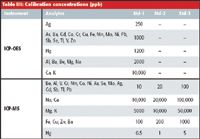
Table III: Calibration concentrations (ppb)
Quality Control
Quality control checks for both instruments were performed in a similar manner, following the protocols described in methods 200.7 and 200.8.
An initial check of calibration accuracy was performed with an independently prepared quality control standard (QCS) for both instruments. A solution at 50% of the concentration of the highest calibration standard was used for this. The results of these measurements were deemed acceptable if the measured value was within 5% of the true concentration for ICP-OES and within 10% of the true value for ICP-MS. Ongoing instrument accuracy was checked by analyzing a quality control standard at an interval of once every 10 samples. This is known as an instrument performance check (IPC) in method 200.7, or a continuing calibration verification (CCV) in method 200.8. These solutions were prepared at the same concentration as the calibration standard for ICP-OES and at the same concentration as the mid-standard (Std-2) for ICP-MS.
Detection Limits
Method detection limits (MDLs) were estimated using the procedure specified in 40 CFR part 136, Appendix B (12).
Accuracy
The accuracy of the methodologies for the analysis of real samples was assessed by analyzing known certified reference materials (CRMs) including river water, hard drinking water, and soft drinking water. Spike recoveries also were performed on unknown samples, although the results of these are omitted here for the sake of brevity.
Long-Term Stability
The long-term stability of the instruments was assessed by plotting the results of the ongoing calibration accuracy QC standard over the course of long analytical runs of more than 150 samples in total.
Results and Discussion
MDLs
The MDLs determined for each technique are given in Table IV. The table also shows typical levels of interest (LOIs), based upon the levels specified in references 13–15. Typically, it is desirable to have MDLs that are an order of magnitude lower than the LOI for each element. Clearly, ICP-OES is a borderline technique for determining Ag, As, Be, and Hg when applying these criteria. If ICP-OES is used for regulatory drinking water analysis, it would probably be necessary to run these elements by alternative techniques to achieve the required detection limits with the degree of confidence required. This could be done by graphite-furnace atomic absorption spectrophotometry (GF-AAS), or by vapor generation AA or atomic fluorescence in the cases of As and Hg. ICP-MS, however, has significant detection overhead for all elements of interest. In addition, the use of a CRC provides further detection overhead for several key elements, notably As, Fe, Se, and V. This is because this mode of operation removes interferences that typically increase the apparent background levels for these elements: ArCl, ArO, ArAr, and ClO, respectively. Note that the sample matrix required for stable silver data adds chloride, which in turn increases the background and MDL for both arsenic and vanadium.

Table IV: MDLs for ICP-OES and ICP-MS. MDLs for ICP-MS run in collisionâreaction cell mode are also shown where significant advantage is obtained over standard ICP-MS mode
Quality Control
The pooled results of successive measurements of quality control standards are shown in Figures 1 and 2, for ICP-OES and ICP-MS, respectively. The figures show the mean percentage recovery for each analyte and the spread of recoveries at 1 standard deviation from the mean. Data are pooled from 45 measurements during three analytical runs for each technique. The figures show that both techniques produce accurate results that are well within the acceptable range of 90–110% recovery specified in methods 200.7 and 200.8. The overall accuracies for both techniques are similar, but the precision of ICP-MS appears slightly better than that of ICP-OES.
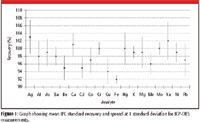
Figure 1: Graph showing mean IPC standard recovery and spread at 1 standard deviation for ICP-OES measurements.
Accuracy
The vast majority of elements show excellent agreement with the expected certified reference material values for both techniques as shown by the average recoveries given in Figure 3 for a number of reference waters. However, a few elements showed small discrepancies. For the NIST 1640 river water reference material, results were somewhat low for Cd, Fe, and Sb by ICP-OES. Similarly, for the hard drinking water, CA010A, Al and Sb were low by ICP-OES and Cr was low by ICP-MS. For the soft drinking water, CA021A, Al, As, and Cd were low by ICP-OES. Many of these low results were at concentrations close to the MDL of ICP-OES, and the accuracy is likely to degrade near the MDL. In general, ICP-MS tends to give better accuracy for the majority of elements at these typical concentrations in water samples.
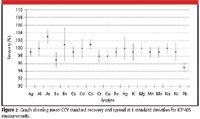
Figure 2: Graph showing mean CCV standard recovery and spread at 1 standard deviation for ICP-MS measurements.
Long-Term Stability
The long-term stability of the instruments during the analysis of real water samples was evaluated by plotting the normalized results of quality control standards for an analytical run. This represents the analysis of 140 unknown samples. The results are shown graphically in Figures 4 and 5. Both instruments show broadly similar long-term stability with none of the results deviating from the initial reading by more than 10%. The mean drift away from the initial reading for both instruments is close to zero. Both instruments are therefore deemed suitable for analyzing large numbers of such samples over long periods with relatively infrequent recalibration.
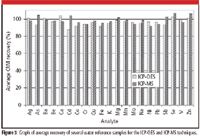
Figure 3: Graph of average recovery of several water reference samples for the ICP-OES and ICP-MS techniques.
Conclusion
This study has shown that laboratories that wish to perform regulatory analysis of trace elements in drinking water samples will be best served by ICP-MS. The required detection limits for this type of analysis are close to the limits of ICP-OES for analytes such as silver, arsenic, beryllium, and mercury, while ICP-MS offers significant detection limit advantages for all of these difficult elements. If ICP-OES is still to be used, then these elements could be analyzed separately using GF-AAS, or vapor generation AA or atomic fluorescence spectroscopy (AFS) in the case of arsenic and mercury. For most water samples, ICP-MS provides more than satisfactory performance, even for interference-ridden elements like arsenic, without the need to use CRC technology. CRC technology does, however, provide significant detection limit improvements for several elements, including iron, arsenic, selenium, and vanadium. For NPDES analyses, ICP-OES is still a perfectly suitable technique and can provide advantages over ICP-MS thanks to its greater ability to cope with higher sample matrix concentrations. ICP-OES is particularly well suited to the typically dirtier samples received in this line of work.
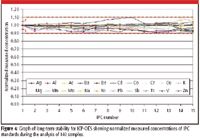
Figure 4: Graph of long-term stability for ICP-OES showing normalized measured concentrations of IPC standards during the analysis of 140 samples.
In summary, ICP-MS is the closest there is to a universally applicable technique for trace element analysis. CRC technology significantly extends the applicability of the technique and should be included and allowed in future revisions of standard methods. ICP-OES remains a solid and reliable technique for dirtier samples, but is indeed beginning to struggle to confidently meet the required detection limits for drinking water analysis.
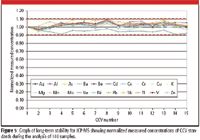
Figure 5: Graph of long-term stability for ICP-MS showing normalized measured concentrations of CCV standards during the analysis of 140 samples.
* Shortly before going to press, the authors learned that the FDA recently approved ICP-MS method 200.8 for NPDES measurements.
Bill Spence, Environmental Market Specialist — Trace Element Analysis Products; Karen Harper, Applications Group Leader; Julian Wills, Senior Application Specialist ICP-MS; and Fergus Keenan, North America Field Marketing Manager, are with Thermo Fisher Scientific.
References
(1) USEPA-ICP Users Group (Edited by T.D. Martin and J.F. Kopp), Method 200.7, Revision 1.0, (printed 1979, published 1982).
(2) T.D. Martin, C.A. Brockhoff, J.T. Creed, and EMMC Methods Work Group, Method 200.7, Revision 4.4 (1994).
(3) S.E. Long, T.D. Martin, and E.R. Martin, Method 200.8, Revisions 4.2 and 4.3 (1990).
(4) J.T. Creed, C.A. Brockhoff, and T.D. Martin, Method 200.8, Revision 5.4 (1994).
(5) National Primary Drinking Water Regulations; Arsenic and Clarifications to Compliance and New Source Contaminants Monitoring, Federal Register, (January 22, 2001 (Volume 66, Number 14)), http://www.epa.gov/EPA-WATER/2001/January/Day-22/w1668.htm.
(6) E.H. Evans and J.J. Giglio, J. Anal. At. Spectrom. 8, 1–18 (1993).
(7) W.J. McShane, R.S. Pappas, and D. Paschal, J. Anal. At. Spectrom. 22, 630–635 (2007).
(8) E. McCurdy and G. Woods, J. Anal. At. Spectrom. 19, 607–615 (2004).
(9) S.E. O'Brien, B.W. Acon, S.F. Boulyga, J.S. Becker, H.-J. Dietze, and Akbar Montaser, J. Anal. At. Spectrom. 18, 230–238 (2003).
(10) P. Leonhard, R. Pepelnik, A. Prange, N. Yamada, and T. Yamada, J. Anal. At. Spectrom. 3, 189–196 (2002).
(11) Guidelines Establishing Test Procedures for the Analysis of Pollutants Under the Clean Water Act; National Primary Drinking Water Regulations; and National Secondary Drinking Water Regulations; Analysis and Sampling Procedures, (April 6, 2004 (Volume 69, Number 66)), http://www.epa.gov/EPA-WATER/2004/April/Day-06/w6427.htm
(12) 40 CFR part 136: Guidelines Establishing Test Procedures for the Analysis of Pollutants, Appendix B: Definition and Procedure for the Determination of the Method Detection Limit—Revision 1.11.
(13) 40 CFR part 141: National Primary Drinking Water Standard (2002).
(14) 40 CFR part 143: National Secondary Drinking Water Standard (2002).
(15) Guidelines for drinking-water quality, third edition, incorporating first addendum, World Health Organization (2006).
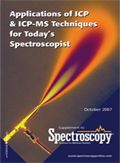
High-Speed Laser MS for Precise, Prep-Free Environmental Particle Tracking
April 21st 2025Scientists at Oak Ridge National Laboratory have demonstrated that a fast, laser-based mass spectrometry method—LA-ICP-TOF-MS—can accurately detect and identify airborne environmental particles, including toxic metal particles like ruthenium, without the need for complex sample preparation. The work offers a breakthrough in rapid, high-resolution analysis of environmental pollutants.
Trending on Spectroscopy: The Top Content of 2024
December 30th 2024In 2024, we launched multiple content series, covered major conferences, presented two awards, and continued our monthly Analytically Speaking episodes. Below, you'll find a selection of the most popular content from Spectroscopy over the past year.